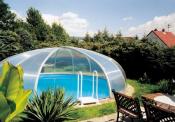Search
Login
Recommended
Basement siding in construction, types of basement siding, DIY installation of basement siding
The basement is an easily vulnerable part of the building, which is constantly exposed to various mechanical effects, the negative manifestation of climatic conditions. Currently, the list of finishing materials intended for facing not only the basement, but also the facade of the building as a whole, is headed by basement siding. Due to its unique texture, it not only protects the external walls from destruction, but also gives the building an additional aesthetic appeal.
Content
- The concept of basement siding, scope
- Advantages and disadvantages of basement siding
- Types of basement siding
- Methods of mounting panels for finishing siding basement
- Useful Tips
The concept of basement siding, scope
Basement siding is made by casting polymer components, followed by the use of thermoplastic machines. Unlike traditional polyvinyl chloride siding, the basement has increased strength, a greater thickness of the front panels, as well as a wide range, including all kinds of shades.

Basement panels are used for:
- Facing the foundation, walls of the building;
- Decorating the porch, porch;
- Finishing decorative elements indoors;
- Constructions of ventilated, insulated facades;
- Dressing of baths, fences, garages, arbors;
- Furnishings with high humidity.
A rather diverse area of \u200b\u200buse of basement siding largely depends on the high performance of the material.
Advantages and disadvantages of basement siding
Each finishing material is characterized by certain advantages and disadvantages, including basement siding. Although the positive aspects of the material during operation significantly exceed the negative.
Advantages of basement siding:
- Environmental friendliness of the material;
- High resistance to sharp temperature fluctuations;
- Not susceptible to corrosion;
- Resistance to mechanical stress;
- Excellent moisture resistance;
- Biological and chemical resistance;
- Not subject to heating and hypothermia due to special additives;
- The invariance of the color shade under the influence of ultraviolet;
- Excellent compatibility with various finishing materials;
- A variety of shapes and colors;
- Lack of delamination, peeling, cracking with time;
- Ease of installation;
- Minimum care;
- There is no need for painting or repair of panels during operation;
- Relatively light weight panels;
- The service life is more than 50 years.

Disadvantages:
- Under the influence of open fire, it begins to melt, not supporting combustion;
- High price.
The combination of a mass of quality characteristics in the basement siding puts it on a par with such facing materials as natural stone, brick. However, the cost of basement siding is several times less than the cost of natural raw materials.
Types of basement siding
Today, basement siding is in ever-growing demand of consumers, which encourages manufacturers to increase the product range, contributing to the development of new varieties of this material. Currently, basement siding is represented by 5 main types:
-
Brick - at a distance of 1 meter from the building visually is no different from masonry with real brick.

-
Stone is a fairly plausible imitation of the masonry of both different breeds of natural and artificial stone.

-
Shingles - characterized by neat fibers over the entire surface of the panel, although in some places random tracks from a chainsaw can be seen.

-
Chips, unlike shingles, are not without various recesses, irregularities, imitating a genuine resemblance to roughly hewn boards.

-
Scales are a fairly new look, used mainly for decorating the upper part of the walls. Panels of this type are very similar to flake plates, which is why they got this name. Elements of the building, faced with this type of siding, immediately attract attention with unsurpassed originality.

The small number of types of basement siding pales in front of an extensive range of colors, sizes and textures produced by various manufacturers of siding. For example, fineber basement siding is represented by an excellent imitation of panels for slate, natural stone, brick.
Methods of mounting panels for finishing siding basement
Installation of basement siding is carried out using a latch lock or a thorn lock in a groove. The choice of one or another mounting method largely depends on the type of cap:
-
A flat base uses a latch;

-
The speaker needs a spike lock in the groove;

-
Latching is ideal lock-latch.

Installation of basement siding is greatly simplified compared to conventional siding. This is explained by the presence of special images on panels with a form factor. The essence of the risks is to reflect the air temperature during the direct installation, while the panels are joined together with an overlap, while the temperature risks are combined.
In addition to the presence of risks, some basement panels with a form factor are additionally equipped with an integrated thermometer that records the temperature of the panel itself. In this case, the docking of the panels is carried out between the corresponding temperature risks.
With any method of installing basement siding, a wooden or metal crate is first constructed with a step depending on the size of the panel. After that, you can proceed to direct work with panels.

Installation of basement siding with a snap lock
The assembly of basement panels is very similar to the installation technology of conventional vinyl siding.
- Installation of start profiles is carried out:
- Simultaneously with the corner profile, if a smooth corner is provided. In this case, the lower boundary of the starting profile is located above the edge of the angular profile to the height of the vertical temperature gap. At the same distance, the corner should not reach the blind area;
- Immediately around the perimeter without an angular profile, if the corner repeats the pattern of mounted panels.
- The first row begins with trimming the end of one panel, designed to enter the corner profile.
- The panel is fastened so that the lower hook of the panel interlocks with the hook of the starting profile. Proper grip ensures that the lock snaps into place.
- The panel is fixed to the crate by stainless screws, first into the round central hole, then into the oval, also in the center. When fixing the siding between the end of the panel and the corner profile, it is necessary to leave a temperature gap.
- If a relief corner is used, then the installation of the first row of panels is made from one and the other side. After that, the corner is latched onto the start profile and fixed by means of the holes located in the upper part. In this case, the combination of the pattern on the corner and the panel is achieved by cutting the angle form factor.
- The second row panel is cut in half or 1/3 of the part. The cut off part can be used on the other side of the building.
- At the end of the installation of overhead corners, moldings are mounted.
- Installation of siding around the openings is carried out:
- U-shaped cut in the panel, if the length of the siding is greater than the width of the window. Provided that the window is located almost in the center of the panel. At the same time, hooks are made on the long cut side, after which the panel winds up in the cavity of the J-profile.
- L-shaped cut if the window is offset from the center of the panel, but the width of the window is less than the length of the panel.
- With a cut of the nail edge, with a window width exceeding the length of the base panel. The panel is fixed by means of a lock-latch.
- After the assembly of the siding is completed, a J-profile or a border is installed.
Mounting base plinths using a spike in groove connection
- A starting strip is installed along the perimeter of the cladding.
- A siding base panel is being tried on, while the panel is inserted into the starting strip from top to bottom so that the column posts freely penetrate into the gutter of the starting profile, preventing the temperature slot from opening.
- After fitting the shape factor picture, the outer corner is attached.
- Installation of the second corner occurs after the complete installation of 1 row of panels.
- By setting the horizontal gap between the corner and the end of the panel, the panel is fixed from the center to the edges.
- The second panel of the first row siding is inserted into the start profile, after which it slides into the grooves of the first panel.
- The first panel of the second row is installed in the grooves of the lower panel, located at the top of the back side. In the absence of grooves, the pins engage with the nail strip below the panel.
- After combining the figure on the form factors of the upper and lower panels, the second row panel is cut to enter the corner profile, taking into account the temperature gap.
- The installation of the second angular profile overlaps the lower corner, taking into account the combination of the form factor pattern, after which the angle is fixed with screws.
- Thoroughly securing the first panel in the second row.
Useful Tips
- Installation of basement siding + do it yourself from left to right, from bottom to top.
- The panels are attached to the crate by means of self-tapping screws or stainless nails.
- To avoid siding deformation, all fasteners are screwed strictly perpendicular to the surface.
- The fastener cap should not press the panel tightly.
- Between the auxiliary profiles, the edges of the panels, it is necessary to leave a temperature gap.
- Before mounting the panels, it is necessary to withstand during the day in a warm place if the installation is carried out at sub-zero temperatures.

Thus, facing a part or the whole house with basement siding + do-it-yourself is not such a difficult task. The main thing is to choose the right lock connection of siding and be patient for painstaking work.





